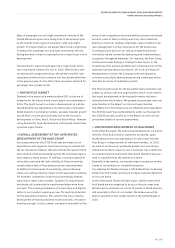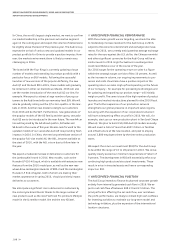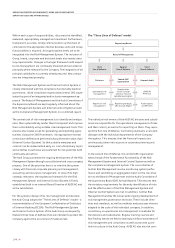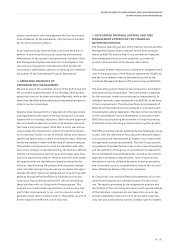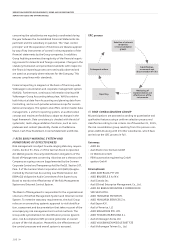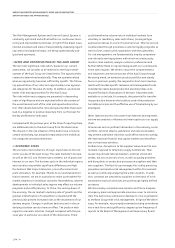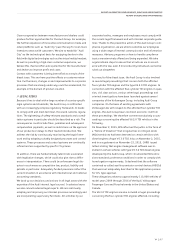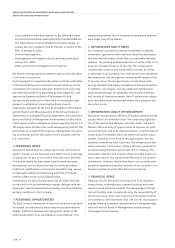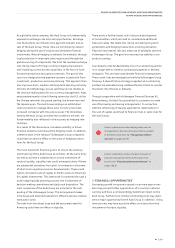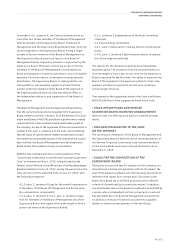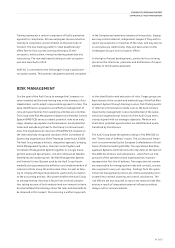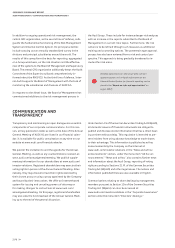Audi 2015 Annual Report Download - page 196
Download and view the complete annual report
Please find page 196 of the 2015 Audi annual report below. You can navigate through the pages in the report by either clicking on the pages listed below, or by using the keyword search tool below to find specific information within the annual report.
REPORT ON EXPECTED DEVELOPMENTS, RISKS AND OPPORTUNITIES
REPORT ON RISKS AND OPPORTUNITIES
196 >>
// RISKS FROM OPERATING ACTIVITIES
It is a characteristic feature of the automotive industry that it
involves high upfront expenditures for future products in the
form of development costs and capital investments. Yet the
payback period generally stretches over a product life cycle
spanning several years. This fundamentally harbors the risk of
deviations from project goals during the product development
and product creation process. The risk of planned product
characteristics failing to meet objectives laid down in the
technical specifications should also be mentioned here.
Changed planning assumptions, deadline overruns and quality
shortcomings could thus have corresponding consequences for
financial targets. Our growing product range and therefore
increasing complexity also add to this risk. In addition, un-
scheduled developments in the market could influence product
decisions, for example product definition and product position-
ing, leading to changes in the development process.
To counter these risks, the Audi Group follows a systematic
product development and product creation process. It involves
a wide range of management and control instruments at cer-
tain milestones to validate both a project’s maturity and its
financial objective. New products are defined on the basis of
a comprehensive analysis of the environment and customers.
In the development phase that follows, we use our extensive
development and supplier network to bring the vehicle project
to production maturity efficiently and in line with premium
standards. This simultaneous engineering approach involves
all divisions. Ongoing target/actual analyses, feasibility studies
and quality checks, accompanied by corresponding escalation
processes, hold financial and technical project risks in check.
It is not possible to fully guarantee the future market success
of new vehicle projects, technologies or services despite exten-
sive market studies and thorough project planning and man-
agement. The main profit and cost drivers in the product de-
velopment and product creation process are managed and
monitored by our Controlling area and as a project management
task. The ratios applied are for project-based cost and profit
management, and for corporate financial management.
In the wake of the diesel issue, the Audi Group is scrutinizing the
product development and product creation process in particular
and optimizing the Internal Control System above all in the area
of powertrain type approval. In addition, future emission tests
are also to be conducted externally and independently.
There are further risks from operating activities if grants already
budgeted are not released in the amount originally planned
due to regulatory changes, potentially leading to financial
expenditure. We address this risk by regularly monitoring the
legal framework and keeping detailed documentation on the
applications submitted. Based on new findings after the bal-
ance sheet date, this risk should decline markedly.
Furthermore, additional risks can result from quality problems.
These may necessitate technical measures which involve a
considerable financial burden if there is no, or only limited,
scope for passing on costs to suppliers.
There are latent operating risks in the form of unforeseeable
events giving rise to losses, such as explosions or major fires.
These can both result in considerable damage to the Compa-
ny’s assets and cause serious disruption to production process-
es. In addition, production operations can be disrupted by
power supply failures or technical failures, in particular of IT
systems. Although these risks harbor considerable potential
impact, their probability is viewed as low. To reduce such risks
we have implemented various preventive measures within the
Company, such as fire protection systems, emergency plans, IT
data backup centers and company fire departments. Adequate
insurance coverage serves to reduce the financial risk. The high
flexibility of the worldwide production network of the Audi
Group, which makes it possible to move production capacity to
other locations, also reduces the risk.
// OPPORTUNITIES FROM OPERATING ACTIVITIES
Further progress has been made in recent years with the inter-
nationalization of the Audi production network. Opportunities
exist in the scope for local sourcing, leading to more reliable
supplies and an improved costs structure for parts and logistics.
There could also be positive effects from increased natural
hedging. In addition to the synergies and cost savings that the
Audi Group enjoys by virtue of being part of the Volkswagen
Group, capacity utilization can be optimally managed across
the worldwide production network, and production planning can
be aligned closely with the requirements of individual markets.



